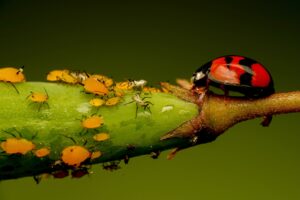 Now that plants are in the ground, you might start noticing pests trying to ruin all the hard work you have put into your garden. Don’t fret, instead learn about a multi prong approach to manage problematic critters in your garden, called integrated pest management, or IPM.
Now that plants are in the ground, you might start noticing pests trying to ruin all the hard work you have put into your garden. Don’t fret, instead learn about a multi prong approach to manage problematic critters in your garden, called integrated pest management, or IPM.
IPM uses different levels of approaches to control pests with the main goals of:
- Minimizing damage and environmental hazards
- Maintaining productivity/aesthetics
The first step when determining the best way to control a pest problem is to identify the plant the problem is occurring on. Different approaches are appropriate for certain plants while others would not be. If the problem is occurring on many types of plants, that can be helpful in identifying the pest as well.
Before you have pests in your garden, you should focus on growing healthy plants as a preventative measure. Healthy plants have fewer pests, and if they do get a pest problem, they are more likely to overcome it. It’s also important to keep in mind that plant needs change throughout the lifecycle of a plant (fertilizer, pruning, water, etc.). The final thing to keep in mind is that plant problems usually arise from a combination of stress factors. Rarely do pests attack and kill healthy plants, so keep your plants happy to keep the pests away. Selecting appropriate plants for our area, and for the specific area you are planting in will cut down on potential issues. Managing your soil conditions (compaction, drainage, tilth, nutrients) will help you to have healthy plants as well.
If you do experience pest issues, consider following the IPM approaches, in order of the least invasive and last resort, the most invasive.
- Water management: Make sure you are applying an appropriate amount of water, overwatering, and underwatering can open up your plants to issues. Try adjusting water needs as a first control method.
- Cultural care: Be sure you have good spacing and air flow, consider your plants exposure to sun and wind, use mulch, and prune appropriately.
- Mechanical methods: For pests this usually involves covers or barriers, and traps.
- Biological controls: Use predators, parasites, disease organisms, and beneficial nematodes that will specifically attack the pest you are experiencing problems with.
- Chemical controls: This should always be the last resort. If you do decide to use pesticides, be sure you always read the label carefully so that you know when you can use it, which plants you can use it on, and which pests it controls. There are also environmental hazards on pesticide labels that will help you keep the environment, including pollinators, safe.
Keeping your plants healthy, and using IPM strategies when you do experience a problem will hopefully keep your plants pest free this season!


